The significant growth in inclusive tour package holidays during the 1950s and 1960s led to the establishment of a number of independent airlines specialising in the provision of charter flights for tour operators. One such airline was Monarch Airlines, formed in June 1967 by two former directors of British Eagle Airlines, Bill Hodgson and Don Peacock, and supported by the large Cosmos Tours holiday group, part of the Globus Travel Group which was originally formed in 1928 by Swiss Italian, Antonio Mantegazza.
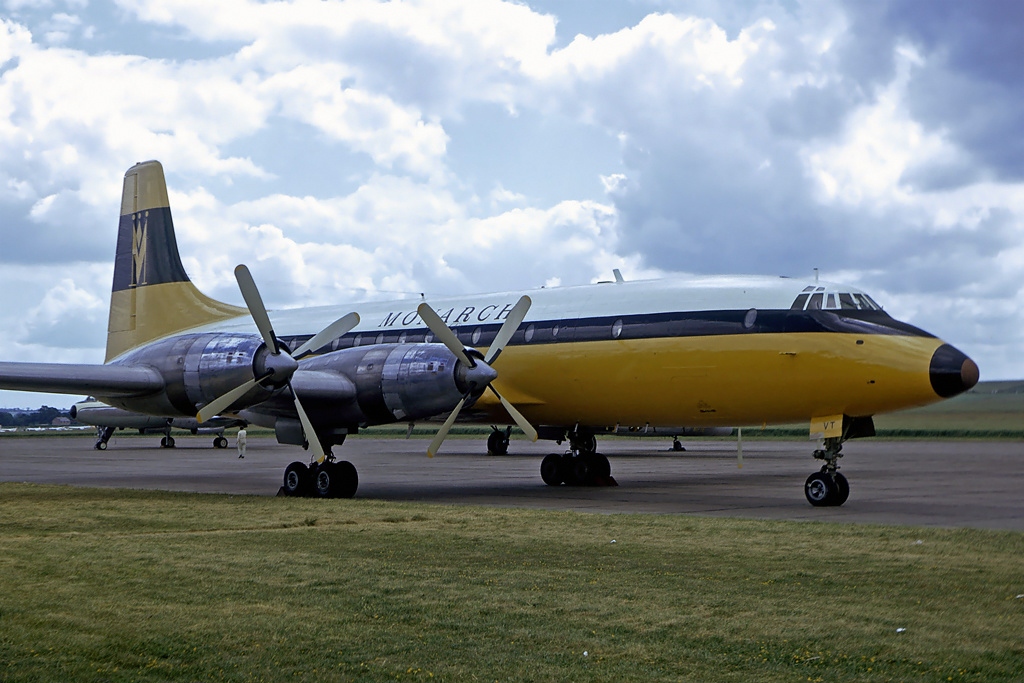
Bristol Britannia 312 G-AOVT remained with Monarch until October 1974. (Steve Fitzgerald, distributed under a GFDL 1.2 Licence)
Monarch established its base at Luton Airport and its first aircraft were two Bristol 175 Britannia 300s acquired from Caledonian Airways. The carrier’s inaugural revenue service took place on 5 April 1968 – an inclusive tour charter from Luton to Madrid. During its first few years of operations Monarch was almost exclusively contracted by Cosmos to operate inclusive tour flights from Luton to a number of European destinations, as well as undertaking a small number of ad-hoc passenger charters for other airlines, all of which led to more Britannias joining the fleet. In November 1968, Monarch was awarded a contract from the Ministry of Technology and Ministry of Defence to transport equipment and personnel for weapons development and testing at the Woomera rocket test range in South Australia. Contracts for trooping flights which involved flying military personnel and their families to bases in West Germany were to follow.
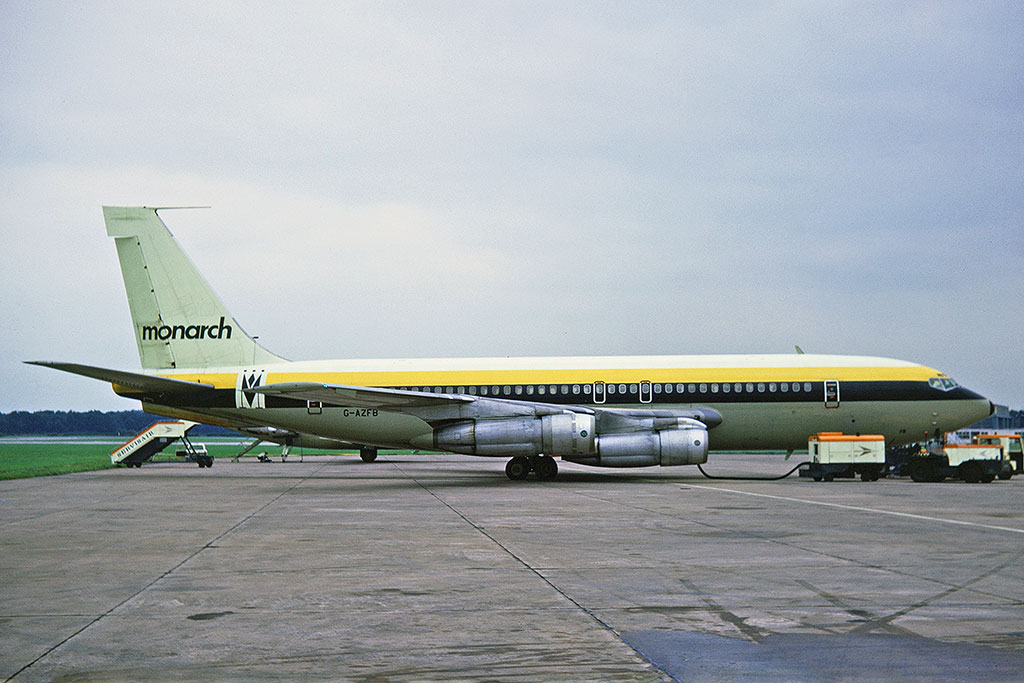
The first Boeing 720B G-AZFB to be acquired by Monarch in November 1971 (Ken Fielding, distributed under a Creative Commons CC BY-SA 3.0 Licence)
Monarch moved into the jet age in November 1971 when it acquired the first of three Boeing 720Bs, and began to replace the ageing Britannias. Its first jet service was in December from Luton to Tunis and by the end of 1972, the Boeing 720Bs had taken over most of Monarch’s passenger services. Following the collapse of Court Line in August 1974, Cosmos Tours started planning for inclusive tours from Bristol Airport in the hope of attracting some of Clarksons’ (one of Court Line’s tour companies) former customers. Two former Court Line BAC One-Eleven Series 500s were leased in 1975 to serve Cosmos’ new package tours from Bristol, as well as flying charter flights from Luton, Birmingham and East Midlands Airport.
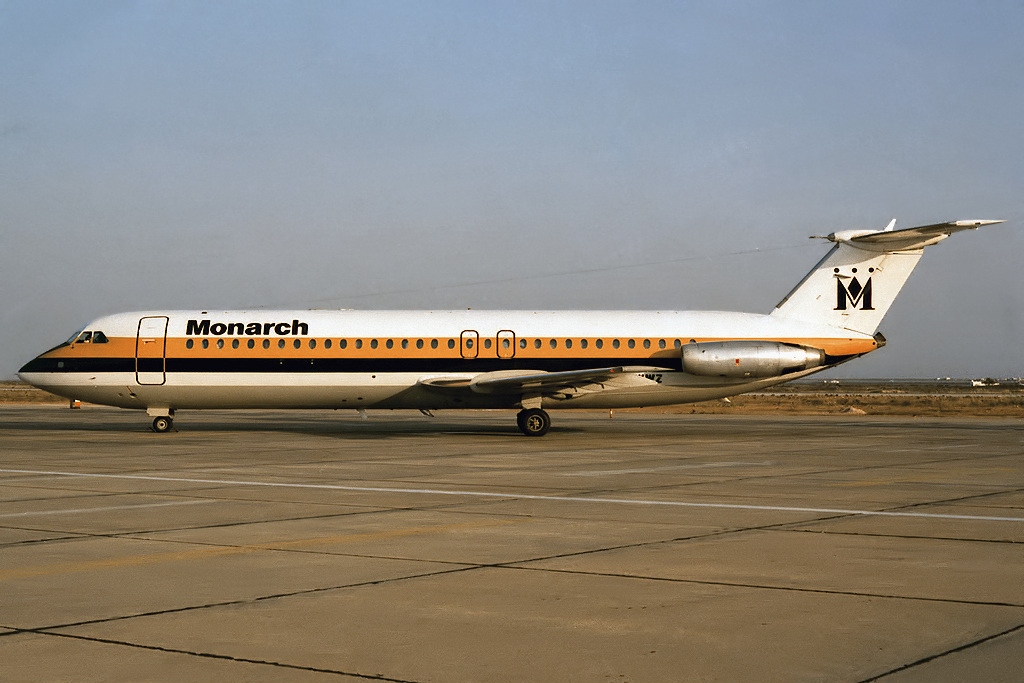
BAC 1-11 500 G-AWWZ at Faro Airport, Portugal in1986 (Pedro Aragão, distributed under a Creative Commons CC BY-SA 3.0 Licence)
Further expansion of the inclusive tour charter business led to the addition of more Boeing 720Bs and another One-Eleven. During 1978 and 1979 Monarch also acquired a Boeing 707-123B for long-haul inclusive tour flights to St. Lucia. At the end of the decade, Monarch’s two founding directors, Bill Hodgson and Don Peacock stepped down from the company. The airline achieved an important milestone in Hodgson and Peacock’s final year in control of Monarch, carrying over one million passengers for the very first time.
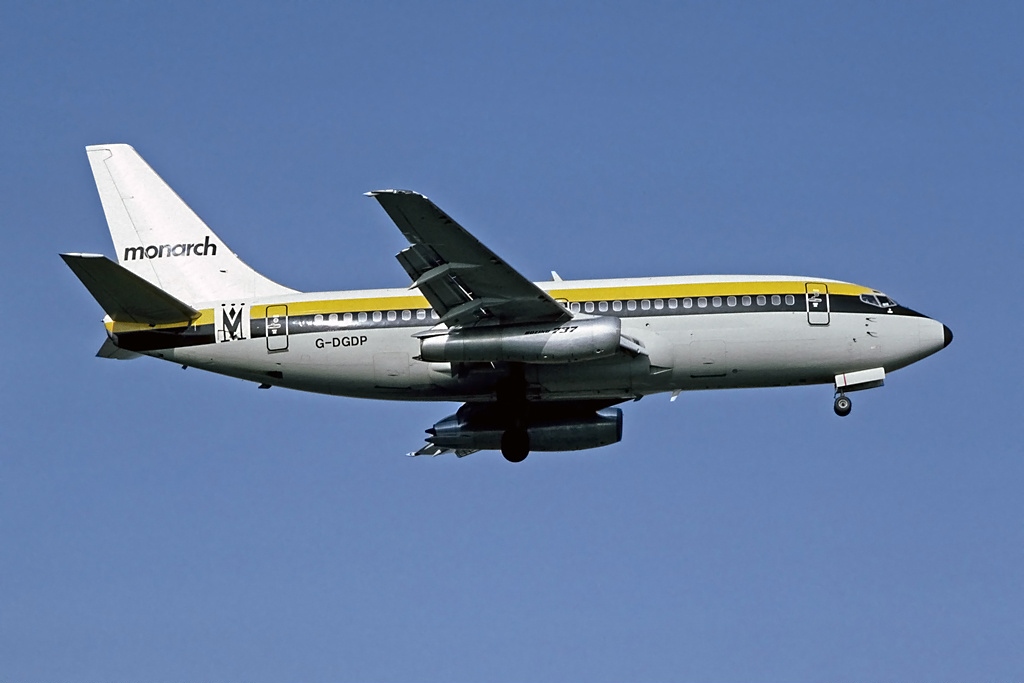
Boeing 737-200 G-DGDP on final approach to London Heathrow in February 1983. (Steve Fitzgerald, distributed under a GFDL 1.2 Licence)
Early in the 1980s Monarch began to expand and modernise its fleet. First to arrive in the autumn of 1980 were several Boeing 737-200 Advanced aircraft which signalled the beginning of the withdrawal of the Boeing 720Bs. In 1981, orders were placed for four Boeing 757-200s and thirteen Boeing 737-300s. The 757s were delivered between March 1983 and March 1985 and the 737s began to arrive in March the following year. By the beginning of the summer season 1986, Monarch had an ‘all Boeing’ fleet consisting of 737-200s, 737-300s and 757-200s, after the retirement of the last One-Eleven in October 1985.
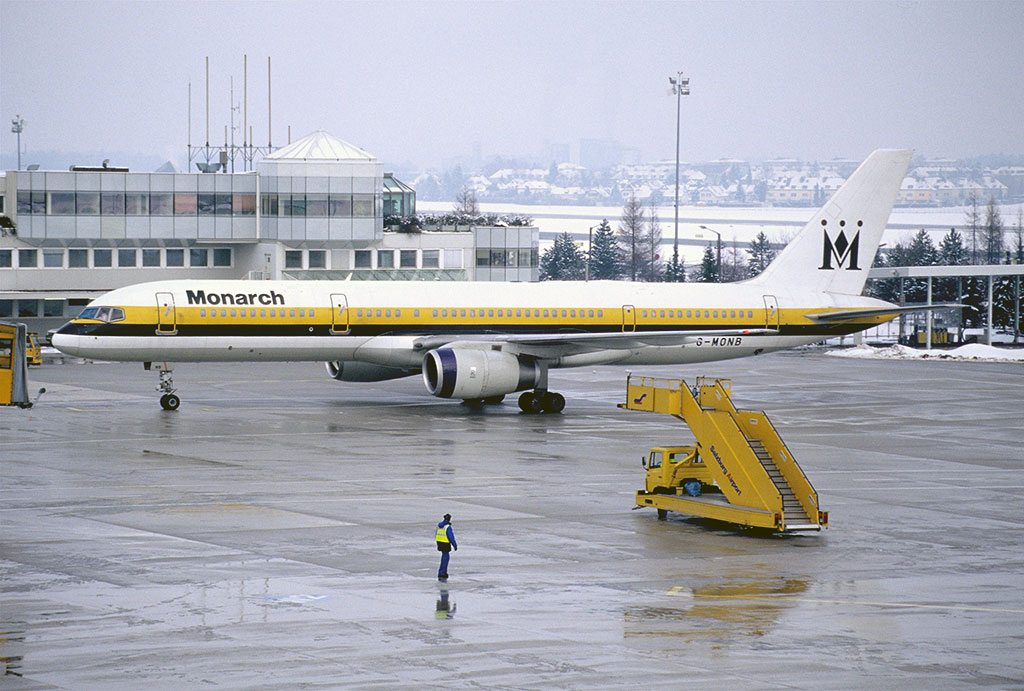
Boeing 757-200 G-MONB was the first aircraft of the type to be acquired by Monarch in March 1983. (Aero Icarus, distributed under a Creative Commons CC BY-SA 2.0 Licence)
Following the UK Government’s relaxation of licensing regulations on scheduled services in 1985, which made it possible for charter airlines to offer flight-only bookings to holiday destinations, the Civil Aviation Authority (CAA) granted Monarch licences to begin scheduled flights from Luton to Malaga, Mahon and Tenerife. These represented Monarch’s first ever scheduled services. Monarch launched its programme of scheduled flights in 1986 under the brand name ‘Monarch Crown Service’ to distinguish it from its charter operations. The first scheduled flight was to Mahon on 5 July 1986.
As the number of Boeing 737-300s in the fleet slowly increased, the last remaining Boeing 737-200 left Monarch in January 1988. On 1 May 1988 Monarch operated the first ETOPS transatlantic flight under CAA regulations. The flight of one of its Boeing 757s from Luton to Orlando was the first ever British-operated twin-jet to cross the Atlantic with passengers.
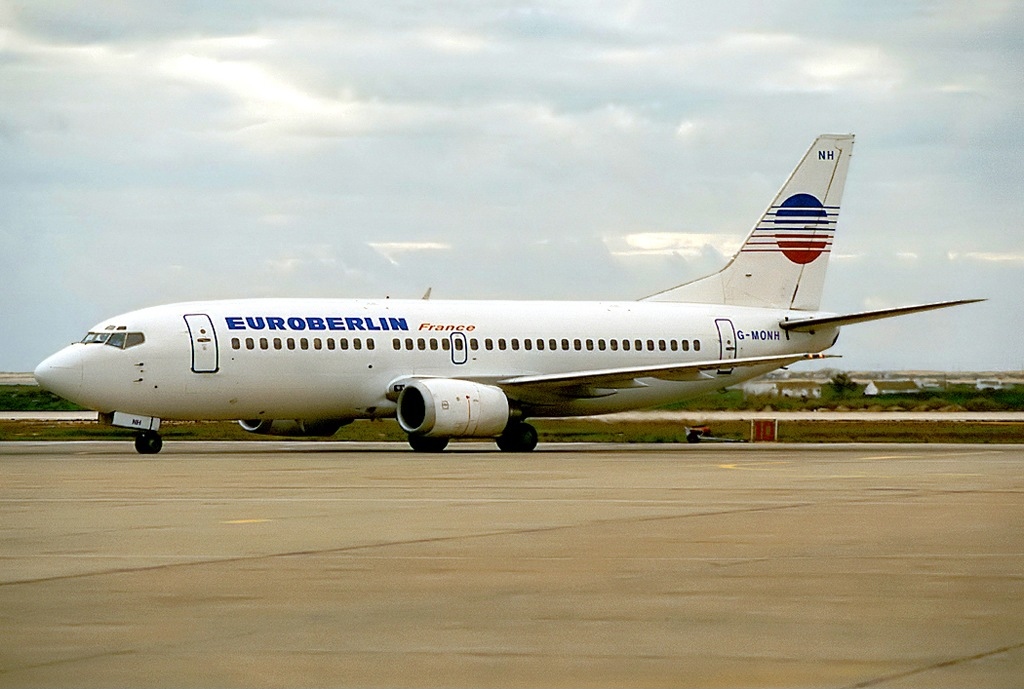
Boeing 737-300 G-MONH being operated by Monarch on behalf of Euroberlin France. (Pedro Aragão, distributed under a Creative Commons CC BY-SA 3.0 Licence)
In November 1988, Monarch wet-leased four Boeing 737-300s to Euroberlin France, a joint venture between Air France (51% share) and Lufthansa (49% share). The aircraft operated scheduled services from Berlin-Tegel Airport to Frankfurt, Cologne, Munich and Stuggart, with the addition of Dusseldorf and Hamburg to the destinations at the start of the 1989 summer timetable. During the winter season 1990/91 Monarch had nine aircraft operating for Euroberlin but by mid-1991 the service was beginning to reduce following the restoration of German Unity in October 1990.
Cosmos Tours (UK), the parent company of Monarch Airlines, changed its status to a public limited company in 1989 and became Monarch Holdings plc. To expand its long-haul provision, Monarch acquired two Airbus A300-600Rs in March 1990, and two more in April 1991. The A300s were deployed on long-haul tour flights to destinations including the Bahamas, Brazil, Kenya, Malaysia, Mexico, Thailand, S.W India, and in the U.S. to Florida, Boston and New York. Monarch also used them for charter flights to some of their most popular Mediterranean destinations.
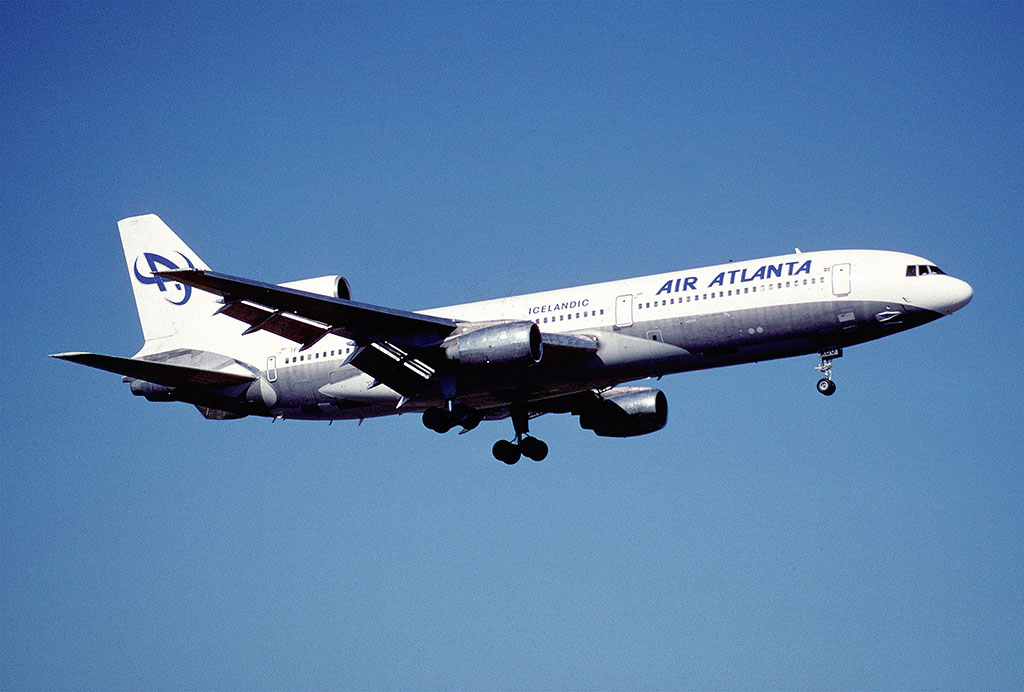
Lockheed L1011-1Tristar TF-ABU was leased by Monarch for the 1998 summer season. (Aero Icarus, distributed under a Creative Commons CC BY-SA 2.0 Licence)
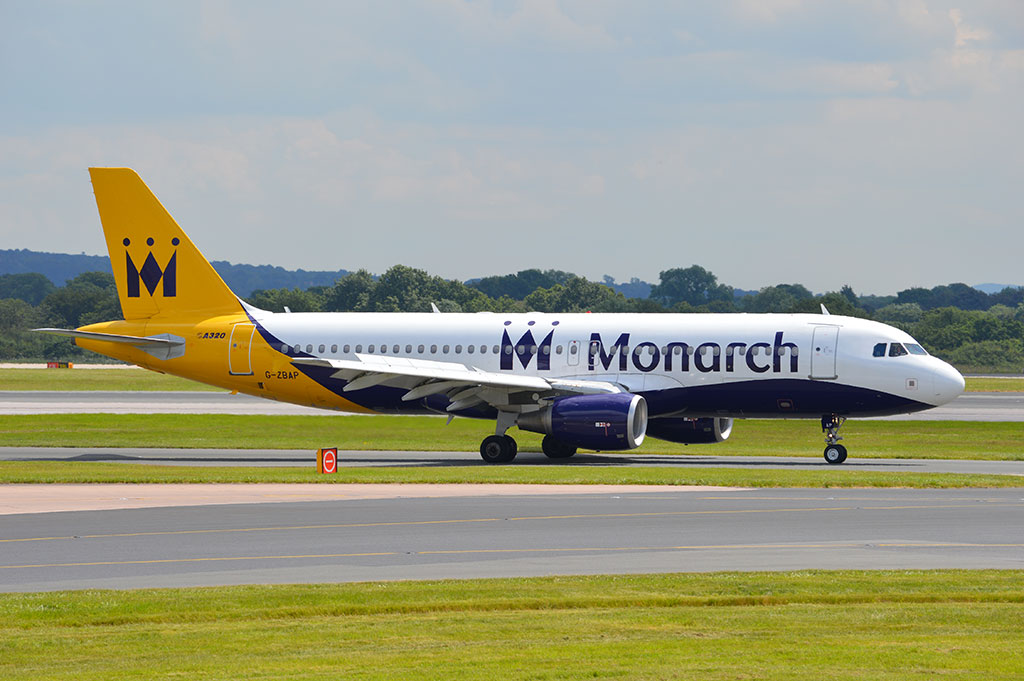
Airbus A320-200 G-ZBAP, one of two A320s acquired by Monarch during 2014. (Nigel Richardson)
Monarch celebrated 25 years of operations in April 1993. The airline was now carrying in excess of three million passengers annually. In the same year Monarch introduced the A320-200 into the fleet to gradually replace the Boeing 737-300s. Another member of the Airbus A320 family joined the carrier in April 1997 with the acquisition of its first A321-200. In order to support its long-haul services, Monarch leased a McDonnell Douglas DC-10-30 in March 1996 and followed this up the following year by placing an order for two Airbus A330-200s. Due to delays in the delivery of the A330s, the airline was forced to lease two McDonnell Douglas MD-11s and a Lockheed L1011-1 Tristar during 1998. The Airbus A330s were eventually delivered in March/April 1999 and, for the first time in Monarch’s history, the aircraft were operated in a two-class configuration: Premium Cabin and Economy, on long-haul services from Gatwick and Manchester to destinations including Orlando, Las Vegas, Jamaica, Cuba, Las Vegas and the Dominican Republic.
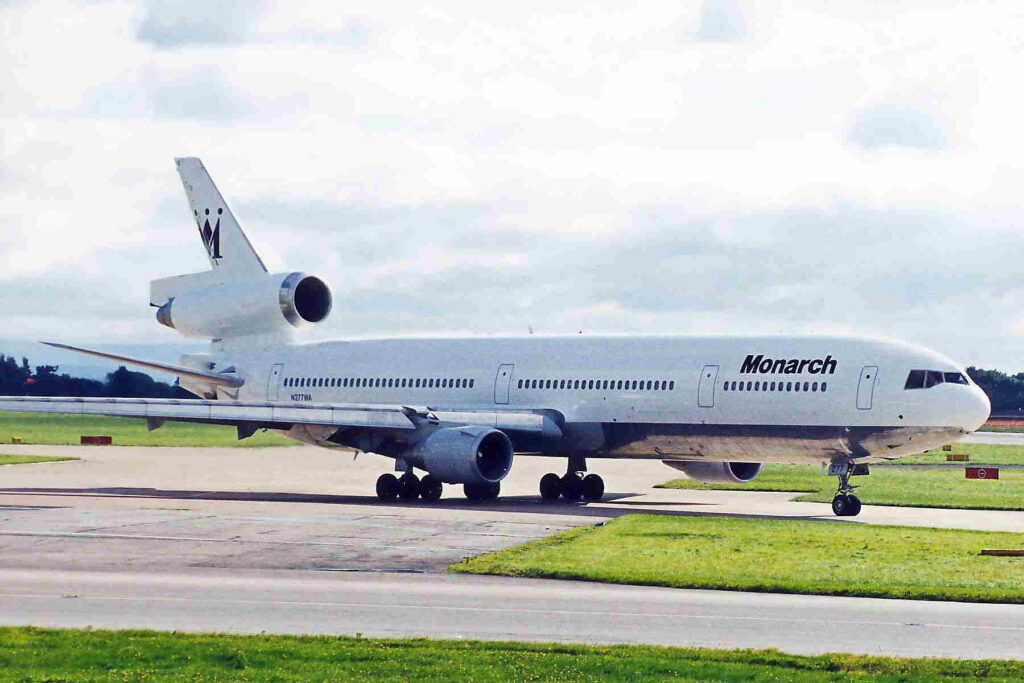
McDonnell Douglas MD-11 N277WA was leased by Monarch between August and November 1998. (Ken Fielding, distributed under a Creative Commons CC BY-SA 3.0 Licence)
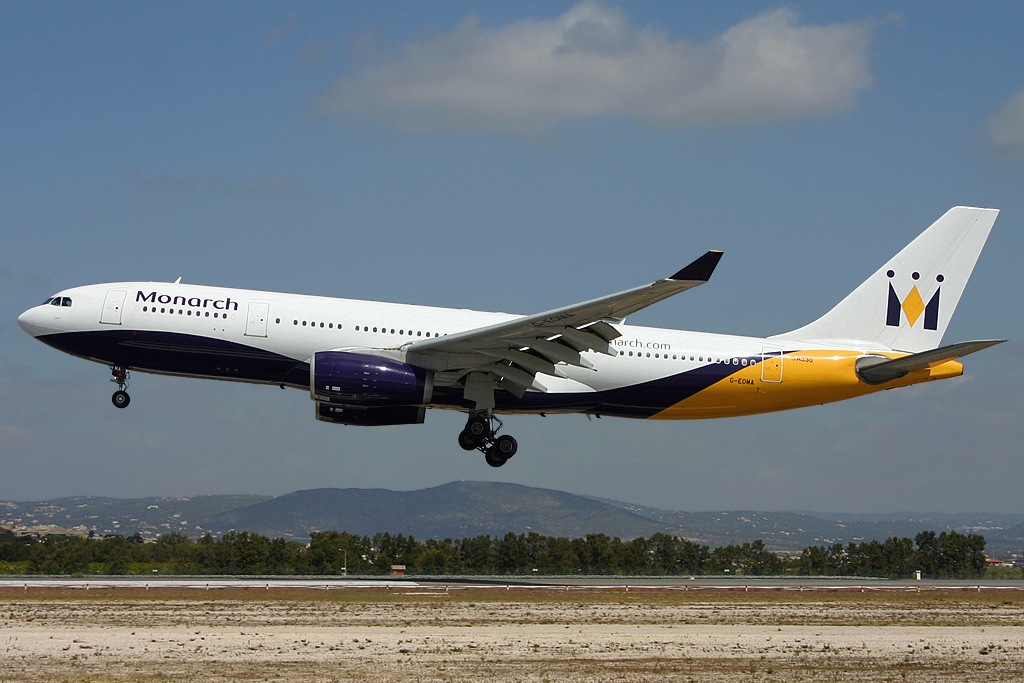
Airbus A330-605R G-EOMA about to land at Faro Airport. (Pedro Aragão, distributed under a Creative Commons CC BY-SA 3.0 Licence)
At the beginning of the 21st Century, Monarch, along with traditional scheduled carriers and other charter airlines, was facing fierce competition from rapidly expanding low-cost, no-frills airlines such as Ryanair and easyJet. Although it had been operating scheduled services since 1986, just under 10% of Monarch’s passengers were carried by scheduled flights in 2000, however, the airline planned to expand its scheduled provision. In 2002, Monarch Crown Service was rebranded as Monarch Scheduled and simultaneously the airline introduced a new aircraft livery. Under the rebranding, Monarch Scheduled continued to offer a similar full service product including free meals, complimentary drinks, newspapers, in-flight entertainment and pre-booked seats free of charge, essentially a ‘low-cost with frills’ carrier. The initial expansion of services provided by Monarch Scheduled was focused on Manchester and a new base at Gatwick Airport.
Despite a 74% increase in the number of passengers carried by Monarch Scheduled in 2003, the airline adopted a modified low-cost model for its scheduled services from July 2004, making passengers pay for all food and drinks on scheduled flights.
Monarch Scheduled opened its first overseas base at Malaga Airport in 2005. Using an Airbus A320 based in Malaga, it operated a number of flights each week to Blackpool, Newquay and Aberdeen from November. However, the Newquay and Blackpool services came to an end in April and October 2006 respectively, and one year later the Malaga-Aberdeen route was withdrawn, leading to the closure of the Malaga base.
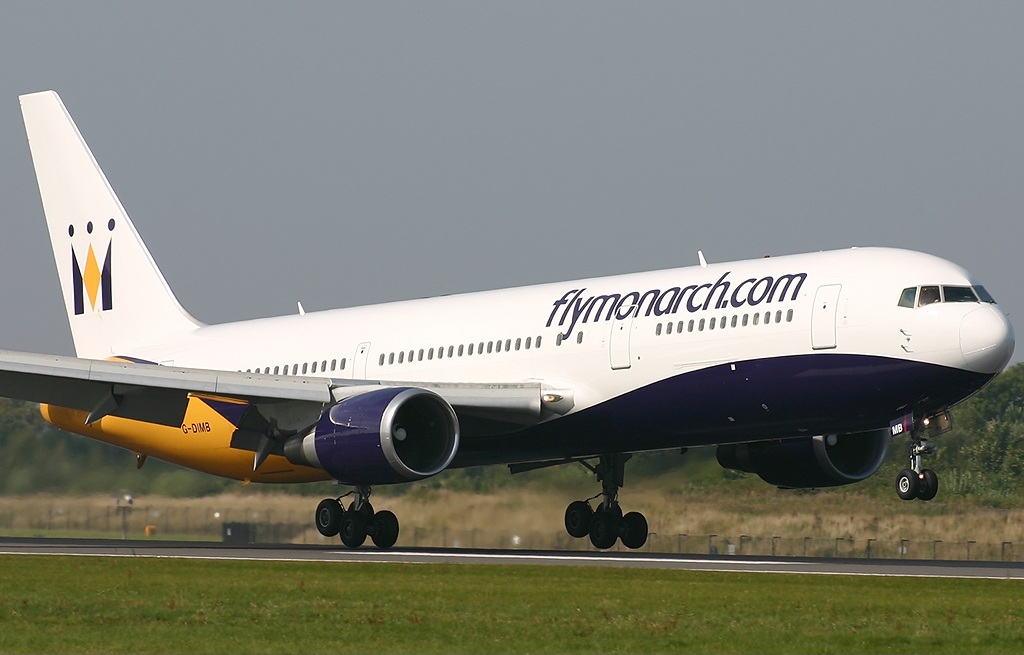
Boeing 767-31 G-DIMB landing at Manchester Airport, September 2005. (Dale Coleman, distributed under a GFDL 1.2 Licence)
In April 2005 Monarch leased a Boeing 767-300ER for five years from MyTravel Airways to supplement the Airbus A330s on long-haul routes. By the end of the year, the airline was flying over 5 million passengers for the second year in succession. Most of the growth in passenger numbers was for scheduled services, with Monarch Scheduled offering a network of 22 routes.
Monarch returned to Boeing in 2006 and placed an order for six 787-8 Dreamliners which were due for delivery in 2010, but due to development problems the date was put back to 2013. The order was eventually cancelled in September 2011. By 2008 Monarch’s fleet had increased to 33 aircraft as the airline looked to further expand scheduled services and offer additional capacity to its charter customers. More A320s and A321s had been acquired but at the end of the year the carrier began to retire its Boeing 757s.
After 41years of continuous, mainly profitable activity, the Monarch Group incurred a pre-tax loss of £30.4 million for the financial year ending on 31 October 2009. The substantial losses were largely attributed to high fuel costs and a decline in market demand due to the economic recession in the UK. In response, the company’s major shareholder, the Mantegazza family, provided a cash injection of £50 million. Despite a challenging start to 2010 culminating in the Icelandic volcanic ash crisis in April, new scheduled services to the Turkish destinations of Bodrum, Dalaman and Antalya were introduced and, after a strong summer performance of both scheduled and charter operations, Monarch returned a profit of £1.5 million for 2010.
In 2011 Monarch changed the focus of its business model from primarily a charter airline to predominantly a scheduled leisure operator. The strategy included an expansion of its scheduled network and a relaunch of its brand using the advertising slogan, ‘Fly your way. Every day’. However, all was not well and in October 2011 the Monarch Group reported a pre-tax loss of £70.2 million. The shareholders provided an additional £77 million of funding, bringing the total financial injection into the Group since October 2009 to £127 million. Along with the refinancing, the Monarch Group implemented a two year turnaround plan, aiming to return to overall profitability by November 2013. Despite the financial difficulties, Monarch continued its route expansion strategy in 2012 and two A320 were added to the fleet. New bases were opened at East Midlands Airport in August 2012 and Leeds Bradford in March 2013. The turnaround plan seemed to be working with the losses reduced to £33.4 million in 2012.
Fleet Renewal Plans
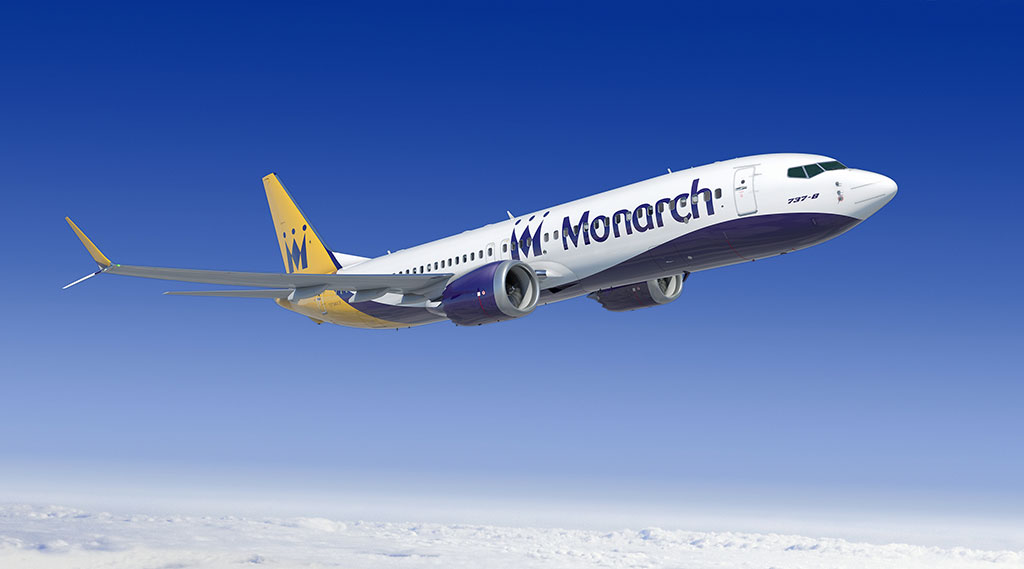
A concept image of a Boeing 737-8 MAX in Monarch livery. (Boeing)
As part of its fleet expansion plans, Monarch took delivery of four A320s and five A321 during 2013 and placed an order worth more than $3.1 billion for thirty Boeing 737 MAX 8s (including options for fifteen aircraft) in 2014, with deliveries due to begin in 2018. However, following a management restructure in July 2014, the new board undertook a strategic review of all parts of the Group’s business. An outcome was the takeover of the company by the private investment company Greybull Capital. The sale was completed in October 2014, from which Monarch secured £125 million of new capital, with £75 million reportedly provided by Greybull Capital and £50 million from the Mantegazza family. The sale of the Group was completed just hours before Monarch’s operating licence from the CAA was due to expire. The strategic review confirmed Monarch’s transition to an entirely scheduled low-cost carrier, focusing on short-haul routes. All long-haul and charter operations were to end by April 2015, leading to the retirement of the A300s and the return of the A330s to the lessor, and the overall fleet size was to be reduced from 42 to 34 aircraft. A route network review led to the closure of the base at East Midlands Airport in April 2015.
Monarch’s mounting financial problems and the reasons for the post-strategic review decisions were confirmed when it reported a pre-tax loss of £57.3 million for the 2013/14 financial year. Following the end of charter flying from the start of the summer season, Monarch carried 5.7 million passengers during 2015, a decline of 18.6 percent compared with 2014. Flight bookings suffered from the impact of the beach terrorist attack in Tunisia in June 2015, which had closed the country as a destination for British tourists, the Greek Eurozone crisis and the migrant crisis in the Eastern Mediterranean. However, bookings to Western Mediterranean destinations and the Canary Islands were above expected levels, and the Monarch Group reported a pre-tax profit of £19.2 million for 2014/15. Further expansion of the route network took place during the 2015/16 winter season and in the summer 2016.
In September 2016, speculation suggested that Monarch was in trouble financially and on the verge of bankruptcy. The CAA became aware of Monarch’s financial problems during the annual renewal process of its Air Travel Organiser’s Licence (ATOL) which was due to expire on the 30 September and, as a contingency, began to make preparations for a ‘shadow airline’ to be established in order to undertake the potential repatriation of approximately 180,000 British citizens who may be left stranded abroad should Monarch go into administration. Following a twelve day extension, Monarch successfully retained its ATOL licence for another year after a £165 million investment from Greybull. One year later it was reported that Boeing had provided £100 million of the £165 million investment to ensure that the airline remained operational and to protect its 737 MAX order.
Monarch’s financial statement for 2015/16 revealed a pre-tax loss of £297.9 million. There had been a 50-60% downturn in bookings for flights to and from Turkey owing to terrorist incidents, and a ban on all direct flights to Tunisia from July 2015 and to Sharm el-Sheikh in Egypt from November 2015 following terrorist attacks. The Brexit Referendum in June 2016 had led to a decline in bookings which was further was compounded by a 20% fall in the value of the Pound against the US Dollar and the Euro. Monarch’s outgoings, especially for fuel and aircraft leases, were paid in US Dollars and Euros, while most of the revenue income was in Pound Sterling.
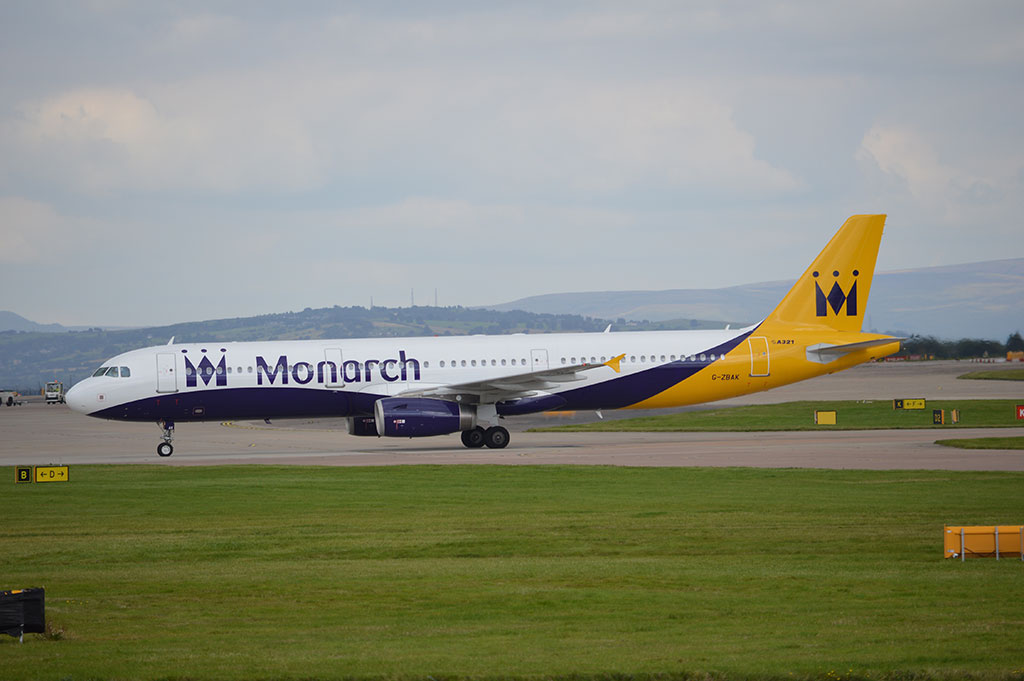
Airbus A321-231 G-ZBAK at Manchester Airport in August 2014. (Nigel Richardson)
Competition from other low-cost carriers on Monarch’s routes intensified in 2017, with even more capacity redeployed, partly as a consequence of the reduction in the number of flights to Turkey, Tunisia and Egypt, and air fares were cut as airlines battled to grow their market share. At the end of September 2017 Monarch, once again, faced the renewal of its ATOL licence. The Monarch Group had already made the CAA aware of their concerns about the airline’s medium and long-term future. A number of options had been considered, including the sale of the business or some of the Group’s assets, but had come to no avail and further investment from the company’s major shareholders or from other sources was not forthcoming. Monarch failed to meet the financial standards required to renew its ATOL licence, despite being granted a 24 hour extension by the CAA from midnight on the 30 September 2017 for emergency talks. At 03.19am on 2 October, the airline’s final service flight from Tel Aviv landed at Manchester Airport. At 4.00am, the CAA confirmed that the Monarch Airlines Group, except for Monarch Aircraft Engineering, had ceased operations with immediate effect and entered into administration. Monarch collapsed with debts of £630 million, of which £466 million was unsecured. At the time, it was the UK’s largest ever airline to cease operations. Some 100,000 customers were stranded overseas.
Following administration, the UK Government instructed the CAA to bring back to the UK all of Monarch’s customers, whether or not they were ATOL protected. This led to what was then the UK’s largest peacetime repatriation effort and involved a fleet of more than 60 aircraft from 24 airlines, and at a cost of £60 million.
At the time of administration, Monarch had a fleet of nine A320-200s, twenty-five A321-300s and a single Boeing 737-800 which had been leased from Pegasus Airlines in preparation for the arrival of the first 738 MAX 8s. The company employed approximately 1,900 staff.
 New Book
New Book
A fully illustrated book by Nigel Richardson describing the history of Monarch Airlines from its inception in 1967 to its eventual demise fifty years later in 2017 will be available this summer from Key Publishing as part of their Airlines Series.

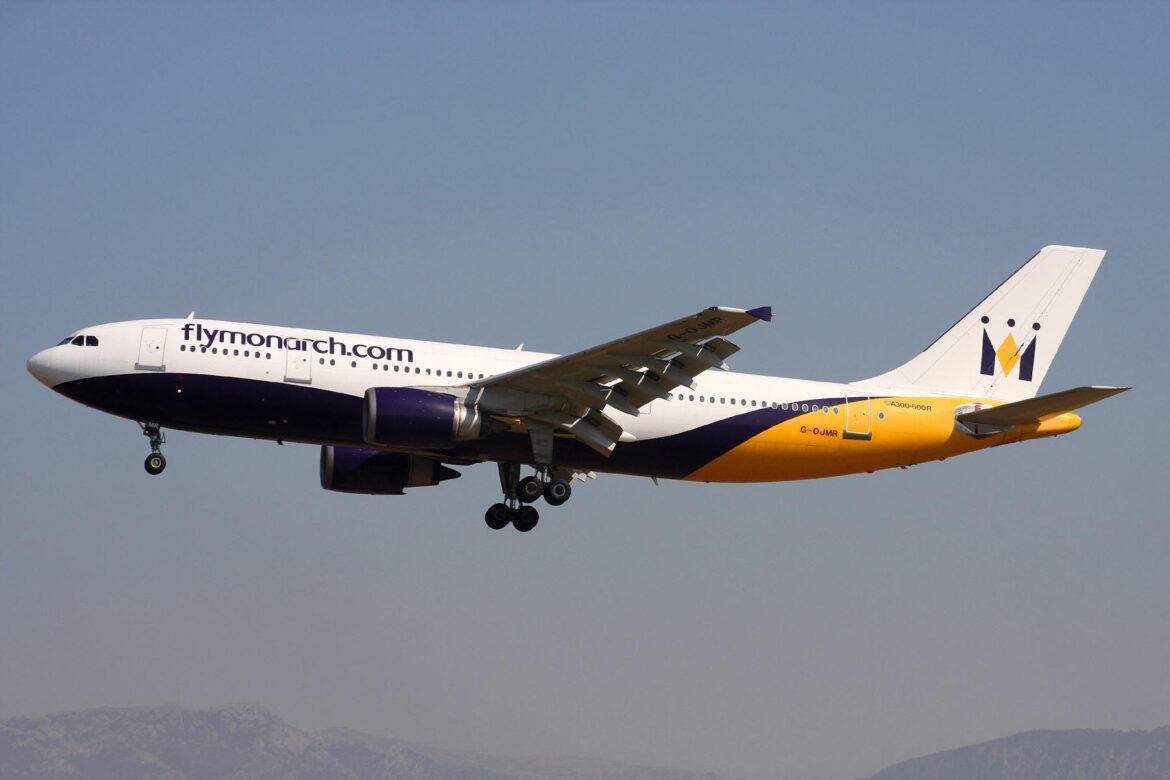
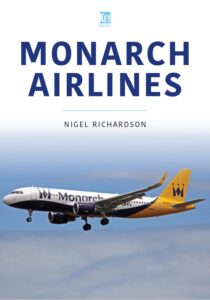 New Book
New Book


2 comments
707-123B? Not a one time QANTAS 707-138B?
No mention of DC10 ? now at the RVP at Manchester.